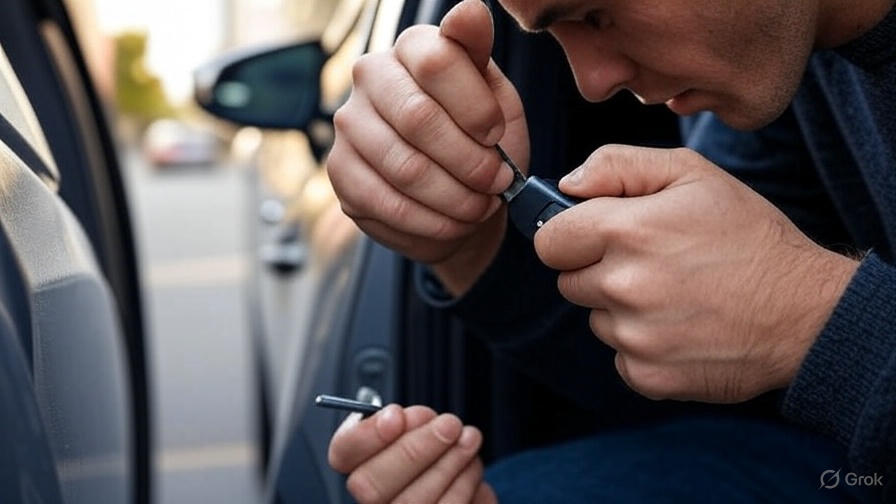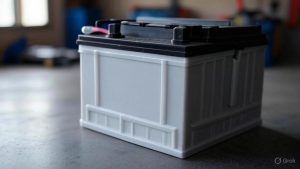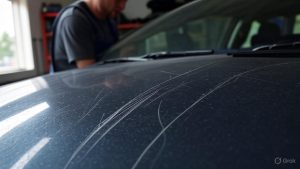Your car sits in the parking lot, and you need to get home. You reach into your pocket, but your key fob feels lifeless. The buttons don’t respond, and panic sets in. Modern vehicles rely heavily on electronic key fobs, but sometimes technology fails us at the worst possible moments.
Dead batteries, damaged circuits, or lost key fobs can leave you stranded. This guide explores legitimate methods to start your vehicle when your key fob stops working, helping you handle emergency situations safely and legally.
Understanding Modern Car Key Systems
Today’s vehicles use sophisticated security systems that go far beyond traditional metal keys. Smart keys, proximity sensors, and encrypted signals create multiple layers of protection against theft. These systems work seamlessly when functioning properly, but they can become obstacles during emergencies.
Key fobs contain small computer chips that communicate with your car’s immobilizer system. This two-way communication verifies that you’re the authorized user before allowing the engine to start. When this system fails, you need alternative approaches to regain access to your vehicle.
Most modern cars still include backup methods for situations exactly like this. Manufacturers recognize that electronic systems can fail, so they build redundancies into their designs. Learning about these backup systems can save you time, money, and stress during unexpected situations.
Emergency Key Blade Method
Hidden inside most key fobs lies a physical metal key called an emergency blade or valet key. This small key provides access to your vehicle when the electronic components fail. Car manufacturers include this feature specifically for situations involving dead batteries or malfunctioning electronics.
To locate your emergency key, look for a small button or slide mechanism on your key fob. Press this button while pulling gently, and the metal key should slide out. Some fobs require you to remove a plastic cover first, so examine your key fob carefully.
The emergency key typically unlocks your driver’s door, though it may not work on all doors or the trunk. Once inside, you can access other methods to start the engine. This physical key serves as your first line of defense against electronic failures.
Different car brands hide the emergency key in various locations. Toyota and Lexus models often have a release button on the back. Ford vehicles may require sliding a cover to reveal the key. BMW and Mercedes models sometimes hide the key behind a removable cap.
Using the Physical Key Slot
Many vehicles equipped with push-button start systems retain a hidden key slot for emergency situations. This slot might be concealed behind plastic covers, inside storage compartments, or near the steering column. Finding this slot can restore normal starting procedures even with a dead key fob.
Check around your steering column for removable plastic panels. These covers often hide traditional key slots that accept your emergency blade. Some vehicles place this slot in the center console, under removable trim pieces, or behind small doors in the dashboard.
Honda and Acura models frequently place the emergency key slot behind a removable panel on the steering column. Nissan vehicles might have it inside a small compartment near the gear shifter. Always consult your owner’s manual for the exact location in your specific vehicle.
Once you locate the key slot, insert your emergency blade and turn it as you would a traditional key. This should activate your vehicle’s electrical systems and allow normal operation of the push-button start system, even with a completely dead key fob.
Key Fob Backup Power Solutions
Sometimes your key fob isn’t completely dead but lacks sufficient power to communicate effectively with your car. Several techniques can extend the remaining battery life or boost the signal strength enough to start your vehicle.
Hold your key fob directly against the push-button start while pressing the button. This method works because many cars have a backup antenna inside the start button that can detect weak signals from very close range. The proximity eliminates interference and maximizes the remaining signal strength.
Try pressing and holding the lock and unlock buttons simultaneously for several seconds. This action can sometimes reset the fob’s internal systems and restore temporary functionality. The reset process varies by manufacturer, so experiment with different button combinations.
Remove the key fob battery and reinstall it after waiting thirty seconds. This power cycle can restore temporary function to fobs with weak or intermittent connections. Clean the battery contacts with a dry cloth to ensure good electrical connection.
Manual Transmission Bypass Techniques
Manual transmission vehicles offer additional options when key fob systems fail. These cars rely less heavily on electronic systems and often include mechanical overrides that automatic transmissions lack.
Pop the clutch method works on manual transmissions when you can access the interior. Push the car to gain momentum, then quickly engage the clutch while shifting into second gear. This technique requires help from others and works best on slight downhill grades.
Ensure the parking brake is released and the steering wheel is unlocked before attempting this method. You’ll need sufficient space and speed to make the engine turn over. This technique works only on vehicles with manual transmissions and should be used carefully to avoid damage.
Some older manual transmission cars allow direct starter engagement by bridging specific terminals under the hood. This method requires automotive knowledge and appropriate tools. Never attempt this unless you understand electrical systems and potential safety hazards.
Professional Locksmith Solutions
Professional automotive locksmiths possess specialized tools and knowledge to handle key fob emergencies safely and legally. They can create new keys, program replacement fobs, or bypass security systems without causing damage to your vehicle.
Licensed locksmiths use advanced programming equipment to create functional key fobs even when you’ve lost all original keys. This process typically takes thirty minutes to two hours, depending on your vehicle’s complexity and security features.
Many locksmiths offer mobile services, coming directly to your location with all necessary equipment. This service proves invaluable when you’re stranded away from home or in unfamiliar areas. Call ahead to confirm they service your specific vehicle make and model.
Quality locksmith services cost significantly less than dealership replacements while offering faster response times. They often provide warranties on their work and can handle multiple key fobs simultaneously if needed.

Dealership Key Replacement Services
Authorized dealerships represent the most reliable source for key fob replacement and programming. They maintain direct access to manufacturer databases and possess factory-approved equipment for all security system functions.
Dealership technicians can create new key fobs using your vehicle identification number and ownership documentation. This process ensures compatibility and proper programming for all vehicle features, including remote start, trunk release, and alarm systems.
Expect to pay premium prices for dealership services, but you’ll receive genuine manufacturer parts and professional installation. Most dealerships require proof of ownership and valid identification before creating new keys.
Schedule appointments in advance, as key programming may require specialized equipment that isn’t always available. Some luxury brands require several days to obtain and program new key fobs, so plan accordingly.
Battery Replacement and Maintenance
Regular key fob battery maintenance prevents most emergency situations involving dead fobs. These small batteries typically last two to four years, depending on usage patterns and environmental conditions.
Most key fobs use common coin cell batteries available at grocery stores, pharmacies, and electronics retailers. Common types include CR2032, CR2025, and CR2016 batteries. Check your owner’s manual or examine the old battery for the correct type.
Replace the battery by opening the key fob case, usually held together by small screws or plastic clips. Handle the circuit board carefully and avoid touching electronic components. Install the new battery with the positive side facing the correct direction.
Test all key fob functions after battery replacement to ensure proper operation. If buttons don’t respond correctly, the fob may require programming or have other internal damage requiring professional attention.
Smart Key Troubleshooting
Smart key systems use proximity sensors to detect authorized keys within the vehicle. When these systems malfunction, specific troubleshooting steps can restore functionality without requiring professional assistance.
Hold the smart key against different locations around the push-button start. Some vehicles have multiple antennas that may still function when primary sensors fail. Try the dashboard, center console, and door handles for alternative detection points.
Disconnect your vehicle’s battery for fifteen minutes to reset the smart key system. This hard reset can clear temporary glitches in the communication between your key and the vehicle’s computer systems. Reconnect the battery and test key functionality.
Check for interference from other electronic devices like cell phones, tablets, or other key fobs. These devices can disrupt the radio frequency communication between your smart key and vehicle. Move potential sources of interference away from the car and key.
Mobile App Solutions
Many newer vehicles offer smartphone apps that can unlock doors and start engines remotely. These apps provide backup access when physical key fobs fail, using cellular networks instead of short-range radio signals.
Download your manufacturer’s official app and create an account linked to your vehicle identification number. Most apps require initial setup while your regular key fob is functional, so complete this process before emergencies arise.
Popular automotive apps include Toyota Remote Connect, Ford Pass, GM OnStar, and Hyundai Blue Link. These apps offer various features beyond remote starting, including vehicle location, maintenance reminders, and theft alerts.
Keep your smartphone charged and maintain active cellular service to ensure app functionality when needed. Some apps require monthly or annual subscription fees, but they provide valuable peace of mind during key fob emergencies.
Aftermarket Remote Start Systems
Aftermarket remote start systems provide additional backup options when factory key fobs fail. These systems operate independently of manufacturer security systems and often include separate remote controls.
Professional installation ensures proper integration with your vehicle’s existing systems without voiding warranties or causing electrical problems. Experienced installers can recommend systems compatible with your specific vehicle and driving needs.
Quality aftermarket systems include bypass modules that work around factory security features when necessary. These modules allow engine starting while maintaining all safety features and anti-theft protections.
Consider two-way remote start systems that provide confirmation signals when commands are successfully executed. This feedback helps ensure your vehicle responds correctly to remote commands from extended distances.
Prevention Strategies
Preventing key fob emergencies proves more effective than dealing with them after they occur. Simple maintenance and preparation steps can eliminate most situations requiring alternative starting methods.
Keep spare key fobs in secure locations like your home or workplace. Having backup keys readily available eliminates the stress and expense of emergency locksmith services or towing charges.
Test your key fob functions regularly to identify weakening batteries before complete failure. Replace batteries proactively when buttons become less responsive or the operating range decreases noticeably.
Learn your vehicle’s emergency procedures before you need them. Practice locating the emergency key blade and finding backup key slots while parked safely at home. Familiarity with these procedures saves valuable time during actual emergencies.
Safety Considerations
Never attempt to start a vehicle that doesn’t belong to you, even if you know these techniques. These methods should only be used on vehicles you own or have explicit permission to operate.
Always verify ownership through proper documentation when seeking professional assistance. Reputable locksmiths and dealerships require identification and proof of ownership before providing key services.
Be aware of your surroundings when attempting any of these methods. Criminals may observe your actions and target you for theft or other crimes. Work in well-lit areas with other people nearby when possible.
Some techniques may trigger your vehicle’s alarm system or security features. Be prepared to explain your actions to security personnel or law enforcement if questioned about your activities.
When to Call for Help
Recognize when professional assistance is necessary rather than attempting potentially dangerous procedures. Complex security systems in luxury vehicles often require specialized equipment and expertise that only professionals possess.
Call for towing services when you cannot safely start your vehicle or when attempted methods risk causing damage. The cost of professional assistance is typically less than repairing damage caused by improper procedures.
Contact emergency services if you’re stranded in dangerous locations or extreme weather conditions. Your safety is more important than the inconvenience and expense of professional assistance.
Modern vehicles include sophisticated security systems designed to prevent unauthorized access and operation. While these systems provide excellent protection against theft, they can create challenges when legitimate owners experience key fob failures.
The methods described in this guide provide legitimate solutions for emergency situations involving your own vehicle. Understanding these techniques before you need them can save time, money, and stress when technology fails at inconvenient moments.
Remember that prevention remains the best strategy. Regular battery replacement, proper key fob maintenance, and keeping spare keys available eliminate most emergency situations. When problems do arise, professional assistance often provides the safest and most reliable solution.
These emergency techniques serve as temporary solutions until you can obtain proper key fob replacement or repair. Don’t rely on bypass methods for extended periods, as they may not provide full security protection or complete vehicle functionality.
Stay informed about your specific vehicle’s features and emergency procedures by consulting your owner’s manual and staying connected with manufacturer updates. Technology continues evolving, and new solutions may become available for your particular situation.




